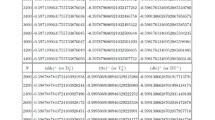Abstract
We propose a method for calculating adiabatic potentials of linear or quasi-linear threesite systems of mixed valence. The method is based on transformation of the potential energy matrix to two effective interacting modes. The adiabatic potential is calculated and its extrema are found. The electronic wave functions at the minima of the adiabatic potential correspond to complex charge distributions in a cluster. The barrier to transition of the “extra” electron between the terminal atoms is lower than for the transition from the terminal atom to the central atom.
Similar content being viewed by others
Literature cited
N. S. Hush, “Electron delocalization, structure, and dynamics,” in: Mixed-Valence Compounds, Riedel, Dordrecht (1982), pp. 150–188.
M. B. Robin and P. Day, “Mixed-valence chemistry — a survey and classification,” Adv. Inorg. Org. Chem. Radiochem.,10, 247–422 (1967).
N. S. Hush, “Inequivalent XPS binding energies in symmetrical delocalized mixed-valence complexes,” Chem. Phys.,10, No. 3, 361–366 (1975).
M. J. Ondrechen, J. Ko, and L. J. Root, “Two-dimensional potential surfaces for bridged mixed-valence dimers,” J. Phys. Chem.,88, No. 24, 5919–5923 (1984).
J. Ko and M. J. Ondrechen, “Line shape of the intervalence transfer band in bridged mixedvalence dimers: the delocalized case,” J. Am. Chem. Soc.,107, No. 22, 6161–6167 (1985).
S. A. Borshch, I. N. Kotov, and I. B. Bersuker, “Electron delocalization in trinuclear mixed-valence clusters,” Chem. Phys. Lett.,89, No. 5, 381–384 (1982).
J. P. Launay and F. Babonneau, “Semiclassical model of a trinuclear mixed-valence system,” Chem. Phys.,67, No. 3, 295–300 (1982).
R. D. Cannon, L. Montry, D. B. Brown, et al., “Partial electron delocalization in a mixed valence iron(III)-iron(II) complex,” J. Am. Chem. Soc.,106, No. 9, 2591–2594 (1984).
S. E. Woehler, R. J. Witterbort, S. M. Oh, et al., “Solid-state2H NMR,57Fe Mössbauer, and X-ray structural characteristics of μ3-oxo-bridged mixed-valence Fe3O(O2CCH3)6(4-Mepy)3 (benzene). Dynamics of the benzene solvate molecules influencing intramolecular electron transfer,” J. Am. Chem. Soc.,108, No. 11, 2938–2946 (1986).
M. J. Powers, R. W. Callahan, D. J. Salmon, et al., “Intervalence transfer in ligandbridged, trimeric complexes of ruthenium,” Inorg. Chem.,15, No. 4, 894–900 (1976).
A. Von Kameke, G. M. Tom, and H. Taube, “μ-Pyrazine polynuclear mixed-valence species based on trans ruthenium tetraamines,” Inorg. Chem.,17, No. 7, 1790–1796 (1978).
K. Y. Wong, “Vibronic coupling model for a three-site single-electron system,” Chem. Phys. Lett.,125, No. 5/6, 485–489 (1986).
C. Joachim and J. P. Launay, “Possibility of a molecular treatment of a signal,” Nouv. J. Chim.,8, No. 2, 723–728 (1984).
I. B. Bersuker and V. Z. Polinger, Vibronic Couplings in Molecules and Crystals [in Russian], Nauka, Moscow (1983).
Author information
Authors and Affiliations
Additional information
Translated from Teoreticheskaya i Éksperimental'naya Khimiya, Vol. 25, No. 2, pp. 129–134, March–April, 1989.
Rights and permissions
About this article
Cite this article
Borshch, S.A., Kotov, I.N. Adiabatic potentials of linear three-site mixed-valence systems. Theor Exp Chem 25, 115–119 (1989). https://doi.org/10.1007/BF01134998
Received:
Issue Date:
DOI: https://doi.org/10.1007/BF01134998




